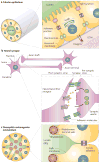From cells to organs: building polarized tissue
- PMID: 18946477
- PMCID: PMC2921794
- DOI: 10.1038/nrm2523
From cells to organs: building polarized tissue
Abstract
How do animal cells assemble into tissues and organs? A diverse array of tissue structures and shapes can be formed by organizing groups of cells into different polarized arrangements and by coordinating their polarity in space and time. Conserved design principles underlying this diversity are emerging from studies of model organisms and tissues. We discuss how conserved polarity complexes, signalling networks, transcription factors, membrane-trafficking pathways, mechanisms for forming lumens in tubes and other hollow structures, and transitions between different types of polarity, such as between epithelial and mesenchymal cells, are used in similar and iterative manners to build all tissues.
Figures




Comment in
-
Outside in: inversion of cell polarity controls epithelial lumen formation.Dev Cell. 2014 Oct 27;31(2):140-2. doi: 10.1016/j.devcel.2014.10.011. Dev Cell. 2014. PMID: 25373773 Free PMC article.
References
-
- O’Brien LE, Zegers MM, Mostov KE. Building epithelial architecture: insights from three-dimensional culture models. Nature Rev Mol Cell Biol. 2002;3:531–537. - PubMed
-
- Lecuit T, Le Goff L. Orchestrating size and shape during morphogenesis. Nature. 2007;450:189–192. - PubMed
-
- Alberts B. Molecular Biology Of The Cell. Garland Science; New York: 2008.
Publication types
MeSH terms
Grants and funding
LinkOut - more resources
Full Text Sources
Other Literature Sources

